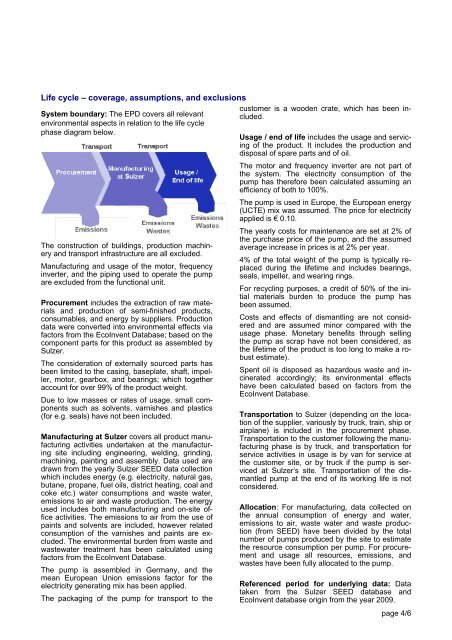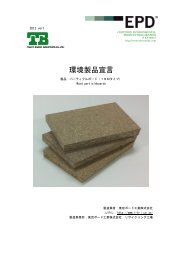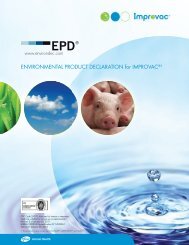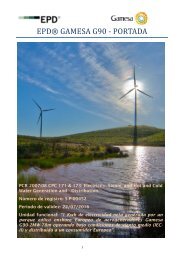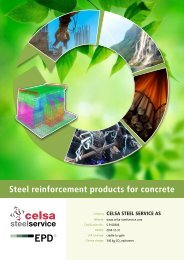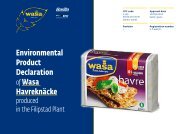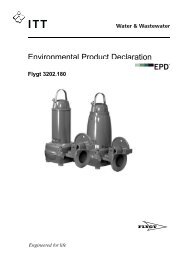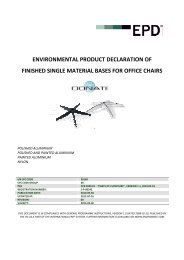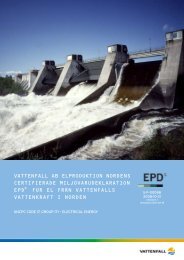GSG High Pressure Barrel Pump - The International EPD® System
GSG High Pressure Barrel Pump - The International EPD® System
GSG High Pressure Barrel Pump - The International EPD® System
You also want an ePaper? Increase the reach of your titles
YUMPU automatically turns print PDFs into web optimized ePapers that Google loves.
Life cycle – coverage, assumptions, and exclusions<br />
<strong>System</strong> boundary: <strong>The</strong> EPD covers all relevant<br />
environmental aspects in relation to the life cycle<br />
phase diagram below.<br />
<strong>The</strong> construction of buildings, production machinery<br />
and transport infrastructure are all excluded.<br />
Manufacturing and usage of the motor, frequency<br />
inverter, and the piping used to operate the pump<br />
are excluded from the functional unit.<br />
Procurement includes the extraction of raw materials<br />
and production of semi-finished products,<br />
consumables, and energy by suppliers. Production<br />
data were converted into environmental effects via<br />
factors from the EcoInvent Database; based on the<br />
component parts for this product as assembled by<br />
Sulzer.<br />
<strong>The</strong> consideration of externally sourced parts has<br />
been limited to the casing, baseplate, shaft, impeller,<br />
motor, gearbox, and bearings; which together<br />
account for over 99% of the product weight.<br />
Due to low masses or rates of usage, small components<br />
such as solvents, varnishes and plastics<br />
(for e.g. seals) have not been included.<br />
Manufacturing at Sulzer covers all product manufacturing<br />
activities undertaken at the manufacturing<br />
site including engineering, welding, grinding,<br />
machining, painting and assembly. Data used are<br />
drawn from the yearly Sulzer SEED data collection<br />
which includes energy (e.g. electricity, natural gas,<br />
butane, propane, fuel oils, district heating, coal and<br />
coke etc.) water consumptions and waste water,<br />
emissions to air and waste production. <strong>The</strong> energy<br />
used includes both manufacturing and on-site office<br />
activities. <strong>The</strong> emissions to air from the use of<br />
paints and solvents are included, however related<br />
consumption of the varnishes and paints are excluded.<br />
<strong>The</strong> environmental burden from waste and<br />
wastewater treatment has been calculated using<br />
factors from the EcoInvent Database.<br />
<strong>The</strong> pump is assembled in Germany, and the<br />
mean European Union emissions factor for the<br />
electricity generating mix has been applied.<br />
<strong>The</strong> packaging of the pump for transport to the<br />
customer is a wooden crate, which has been included.<br />
Usage / end of life includes the usage and servicing<br />
of the product. It includes the production and<br />
disposal of spare parts and of oil.<br />
<strong>The</strong> motor and frequency inverter are not part of<br />
the system. <strong>The</strong> electricity consumption of the<br />
pump has therefore been calculated assuming an<br />
efficiency of both to 100%.<br />
<strong>The</strong> pump is used in Europe, the European energy<br />
(UCTE) mix was assumed. <strong>The</strong> price for electricity<br />
applied is € 0.10.<br />
<strong>The</strong> yearly costs for maintenance are set at 2% of<br />
the purchase price of the pump, and the assumed<br />
average increase in prices is at 2% per year.<br />
4% of the total weight of the pump is typically replaced<br />
during the lifetime and includes bearings,<br />
seals, impeller, and wearing rings.<br />
For recycling purposes, a credit of 50% of the initial<br />
materials burden to produce the pump has<br />
been assumed.<br />
Costs and effects of dismantling are not considered<br />
and are assumed minor compared with the<br />
usage phase. Monetary benefits through selling<br />
the pump as scrap have not been considered, as<br />
the lifetime of the product is too long to make a robust<br />
estimate).<br />
Spent oil is disposed as hazardous waste and incinerated<br />
accordingly; its environmental effects<br />
have been calculated based on factors from the<br />
EcoInvent Database.<br />
Transportation to Sulzer (depending on the location<br />
of the supplier, variously by truck, train, ship or<br />
airplane) is included in the procurement phase.<br />
Transportation to the customer following the manufacturing<br />
phase is by truck, and transportation for<br />
service activities in usage is by van for service at<br />
the customer site, or by truck if the pump is serviced<br />
at Sulzer’s site. Transportation of the dismantled<br />
pump at the end of its working life is not<br />
considered.<br />
Allocation: For manufacturing, data collected on<br />
the annual consumption of energy and water,<br />
emissions to air, waste water and waste production<br />
(from SEED) have been divided by the total<br />
number of pumps produced by the site to estimate<br />
the resource consumption per pump. For procurement<br />
and usage all resources, emissions, and<br />
wastes have been fully allocated to the pump.<br />
Referenced period for underlying data: Data<br />
taken from the Sulzer SEED database and<br />
EcoInvent database origin from the year 2009.<br />
page 4/6


